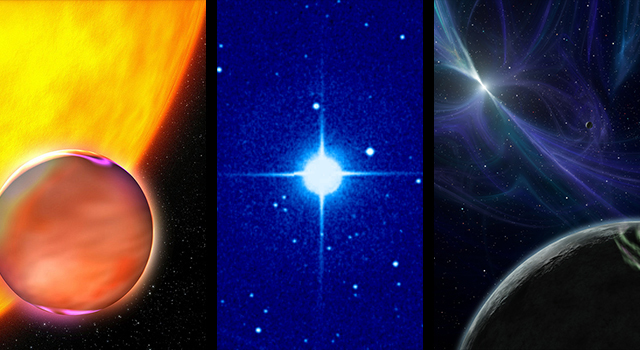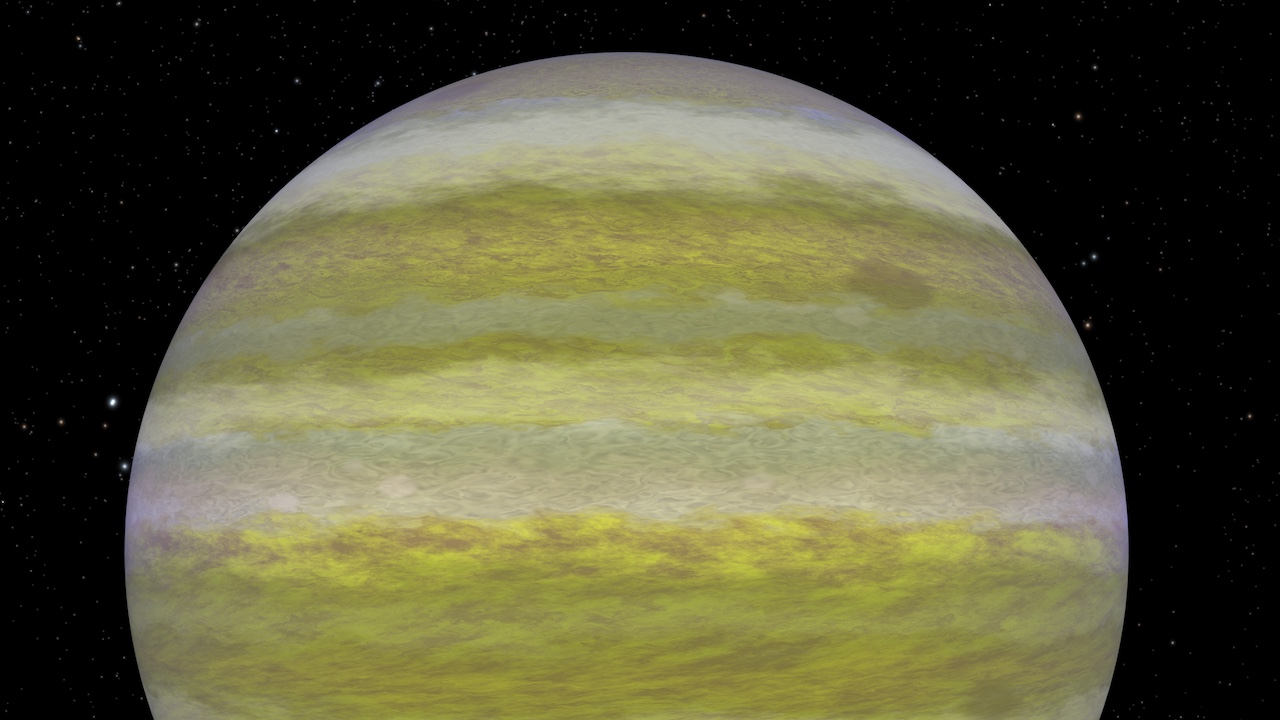5 min read

By Pat Brennan
Exoplanet hunters disagree over who made the first discovery of a world orbiting another star. The question can even inspire a bit of intercontinental rivalry, with both American and European teams laying claim to “firsts.”
The very first planetary bodies outside our solar system to be clearly identified orbit a bizarre object called a pulsar. This is the extremely dense, rapidly spinning core of a star that has died a spectacular death: blowing itself apart in a supernova explosion.
Pulsars shoot intense beams of radio waves in opposite directions as they spin, like rapidly rotating lighthouse beacons. This characteristic came in handy during early attempts to locate planets circling other stars.
By measuring changes in the pulsing beat from just such a spinning, stellar corpse, Dr. Alexander Wolszczan of Pennsylvania State University found three “pulsar planets.” The planets’ gravitational tugs altered the rhythm of the pulsar, revealing their existence by a kind of interstellar Morse code.
Wolszczan announced the discovery of two in 1992, confirming the third two years later.
Many scientists, however, say the strange circumstances that give rise to pulsar planets—not to mention the extreme environment of destructive radiation around a pulsar—make them radically different from planets orbiting still-living stars.
For the first exoplanet detection in that category, the prize goes to a Swiss team led by Michel Mayor and Didier Queloz, who announced their discovery of 51 Pegasi b on October 6, 1995. This is widely acknowledged as the first true exoplanet to be identified in orbit around a normal star, a scientific milestone that proved worthy of a 20th anniversary celebration.
Score that first of firsts for the Europeans.
But the Americans soon entered the spotlight, taking center stage and staying there throughout the early years of planet hunting. A team led out of San Francisco State University went head-to-head with their European competitors.
The team found 70 of the first 100 exoplanets in a legendary burst of planet-hunting that lasted until 2005.
Members of this team headed to the Lick Observatory, on a mountaintop near San Jose, to confirm the existence of 51 Pegasi b.
Their observations over four days matched beautifully the properties of the new planet described by the Europeans. But those properties were so strange that many scientists had difficulty believing it was really a planet.
Fifty-one Peg, as it came to be known, was half the size of Jupiter with a seemingly impossible, sun-hugging orbit: a year on the planet—the time it takes to make one orbit around its star—lasts only 4.3 Earth days.
Later observations confirmed its existence.
The US team might have won the race to find the first exoplanet—if only they’d known what was already in their possession. For months, they’d been recording observations of stars using a light-splitting device called a spectrograph to hunt for stellar wobbles. It was the same method the European team used: capturing subtle changes in starlight being stretched and squeezed as the star moved farther away and then closer to Earth in response to gravitational tugs from an orbiting planet.
They never imagined finding a big, heavy, star-hugging planet with a 4-day orbit. When Butler and the team re-examined their data, they began finding one planet after another: large, hot Jupiters that also were rapidly circling their stars.
Another “almost first” involved a Canadian team that devised the wobble technique. A 1987 press conference brought a revelation: Astronomers Gordon Walker and Bruce Campbell believed they’d found a 2.5-year wobble in the star gamma Cephei—possibly the sign of an orbiting exoplanet. But the announcement was greeted with skepticism; in 1992, Walker rewrote a paper about the discovery on the advice of a colleague, saying the wobble was likely the star’s own pulsations—not the tugs of an orbiting world.
But Walker’s first draft had been correct. In 2003, a Jupiter-sized planet was confirmed to be in orbit around gamma Cephei.

And an important historical footnote raises yet another claim to the real “first,” though one largely dismissed at the time. In the late 1980s, astronomer Dave Latham of Harvard experimented with the same technique that other teams later used: measuring subtle stellar wobbles.
Latham saw something remarkable. A very large object was orbiting a star about 128 light years away. But while he thought it might be a planet, he and other astronomers believed that a small star or even a brown dwarf—a kind of failed star—seemed more likely. Latham’s team said so in their 1989 paper announcing the discovery; the object just seemed too big and too close to its star to be anything else.
In the years that followed, however, discoveries of gigantic, star-hugging planets, now known as “hot Jupiters,” began to pile up. Latham’s object eventually was accepted as a planet, making it a true, if unsung, “first.”
But 51 Peg still manages to retain its first-ever status, and it’s all about the timing. The 1989 announcement suggested a possible planet, though its discoverers lacked enough data to be sure. Confirmation would not come until long after 51 Peg made its big splash in 1995 as the first exoplanet to be reliably identified in orbit around a normal star.
So raise a toast to this star-crisped half Jupiter, the unlikely trailblazer that opened the door to a galactic menagerie of weird worlds taking wild rides around distant stars. Welcome to the age of exoplanets.







